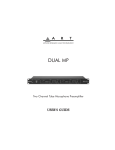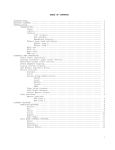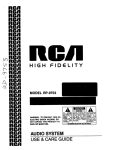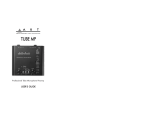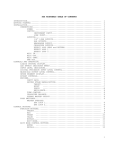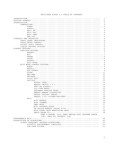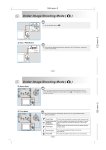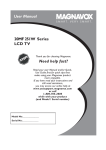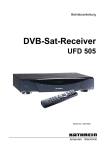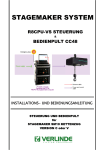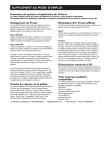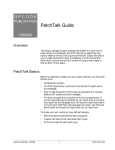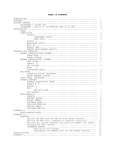Download Art X-15 User manual
Transcript
X-15 USER MANUAL TABLE OF CONTENTS INTRODUCTION CONNECTIONS Power Input MIDI OUT MIDI IN MIDI THRU BYPASS/DC Footswitch TELL-TALES/CONTROLS Numeric Display Power Up LED lndicators Activator Pads Expression Pedals OPERATION MODES PRESET MODE EFFECT MODE BYPASS MDDE SETUP MODE SAVING EDlTED PARAMETERS MISCELLANEOUS APPENDIX A Programmlng Examples Edit Controlled Device's MIDI Program Table (MPT) wlth the X-15 Setup an ART Multiverb, DR-X, or SGE for MIDI Control of the Pitch Parameter of the Pitch Transposer Using the X-15 to Turn On or Off Effects in a Preset Uslng Effect Mode and Activator APPENDIX B Connectlon Illustrations APPENDIX C System Exclusive Messages Unit Handshake Group Parameter Exchange Group Unit Status Group Parameter Exchange Data Format APPENDIX D MIDI: Controllers & Numbers SCALING: Suggestion Settings TROUBLESHOOTING WARRANTY & SERVICE INFORMATION 1 2 2 2 2 2 2 2 2 2 2 2 2 3 3 3 4 4 4 7 7 7 8 8 8 9, 10 11 12 12 12 12 13 13 14 14 INTRODUCTION Congratulations and thank you for purchasing the new ART X-15 ULTRAFOOT Digital Real Time Effects Control System. The ART X-15 ULTRAFOOT puts the power of real time control at your feet in a format that is super-easy to use. The power of the X-l5 is awesome. The ART X-15 ULTRAFOT is a real time MIDI foot controller capable of sending MIDI Program Message Changes to any MIDI controlled device, AND, control MIDI assignable parameters via the TWO real time expression pedals on board, AND, access individual effects of ART SGX and ALPHA effects processors. FEATURES: - Instant access of individual effects - TWO real time assignable expression pedals Simple, “plug in and go” operation DC bypass out jack for use with older units Rugged steel assembly MIDI IN, OUT, &, THRU Send MIDI data on three separate channels at once Durable composite activator pads Mode select allows multifunction use Non-Volatile memory, stores and remembers your changes Bright visible program display Switchable LED indicator lights Extra heavy-duty scuff resistant paint Dump parameters to MIDI storage device The X-15 ULTRAFOOT is a simple device to use extending the flexibility of any MIDI controlled device. For instructions on how to implement and use the X-15 in your system, please read and refer to the rest of this manual. CONNECTIONS Only two connections made to the rear of the X-15 are needed for operation. The only accessories you will need to use your X-15 ULTRAFOOT is a power source and MIDI cable(s). Power Input Plug the power adapter into a proper power outlet then connect to the X-15. MIDI OUT The MIDI output jack is used to transmit all MIDI control information from the X-15 to whichever MIDI device you wish to control. Connect the MIDI cable to the 5 pin MIDI OUT jack on the X-15 and then to the MIDI IN jack of the device you are going to control. MIDI IN This jack receives the MIDI signal containing the MIDI messages. It enables you to “talk” to the X-15 from an external source such as a computer equipped with MIDI ports and associated software or a sequencer. Actually, you may use any MIDI device to send messages to the X-15. Any MIDI information sent to the MIDI In jack is echoed to the MIDI Thru jack. MIDI THRU A MIDI Thru jack is provided on the X-15 allowing you to continue a chain of MIDI devices and let MIDI information pass “thru” the unit to the next one. Information leaving the Thru jack is a direct copy of the MIDI messages received at the MIDI In jack. The information is buffered so the integrity of the signal is not degraded when passing thru. All MIDI Jacks are standard 5 pin DIN connectors utilizing standard MIDI connections. No phantom power is present on the unused terminals. ART recommends these unused terminals remain unused. See Appendix B for MIDI hook-up illustrations. TELL-TALES/CONTROLS NUMERIC DISPLAY The Seven Segment Numeric Display keeps you constantly informed of your Preset Number, Expression Pedal values, MIDI Channel, Programming Characters, and Error Messages. AlI information is displayed using decimal based numbers in most cases. Power up When power is first applied to the X-15, it runs through an autotest sequence turning on everything that lights up for about a second, then it displays “Art” indicating everything is fine. This allows the user to be sure that all display elements are working and that displayed information will be accurate. During power-up the X-15 performs a checksum of the ROM contents, if there is an error, an error message will appear in the display. If the ROM checksum is incorrect, “E-C” will display for ten seconds, press any pad to operate normally. In the event power is interrupted for a brief period of time and the X-15 does not reset itself properly, just unplug and plug back in the power plug at the power in jack. LED Indicators LEDs located in the upper left hand corner of the activator pads 1 through 10 indicate which pad is active. The MODE and BYPASS activator pads have their indicator LEDs located towards their upper right corner. These LEDs are also used to indicate the different programming modes you may be in. ActivatorPads Pads on the pedal are labeled from left to right: Select Arrow UP and Arrow DOWN, MODE, BYPASS, l/EXCITER, 2/COMPRESSOR, 3/DlSTORTlON, 4/EQUALlZER, 5/EXPANDER/NOlSE GATE, 6/REVERB, 7/DELAY, 8/PlTCH TRANSPOSER, 9/FLANGE/CHORUS and 10/SPECIAL EFFECTS. The black activator pads are what you use to activate or program the X-15's many functions. BYPASS/DC FOOTSWITCH Expression Pedals A standard 1/4" jack is the output port for a variety of footswitch configurations. This jack may be programmed to operate in conjunction with the BYPASS pad as a momentary open or closed switch or an on/off switch. Some amp channel switching or other switch applications could be done using this jack. Use a standard two conductor guitar cord to connect this jack to its intended termination. A standard two conductor speaker cable may also be used since no audio is being passed along the conductors. Here are the two pedals that make the X-15 the ultimate MIDI foot controller. The two expression pedals may be programmed individually to control any MIDI controllable parameter in ANY MIDI device. These pedals produce a control voltage using an optical encoding device which is converted into MIDI information. Try to avoid shining extremely bright lights into the pedals. No harm will come to the device, but, you. may affect the operation of the encoders by creating unwanted information. When the pedal is in the full up position, a minimum value is present and as the pedal is gradually pushed down, the value increases to its maximum value when all the way down. OPERATION banks of ten presets. A preset is selected (a MIDI program change message is sent) when a numbered activator pad is pressed. The ART X-15 has four major Modes of operation. These Modes are called PRESET, EFFECT SETUP, and BYPASS Mode. Operation of the X-15 is defined and executed by these Modes. To change between Preset and Effect Mode, you need only to press the MODE activator pad. Each time you press the pad the X-15 toggles between the two modes. Access to Setup Mode is accomplished by pressing the MODE pad and one additional activator pad as described in the Setup section. Bypass Mode is actually one of the programmable sub-modes in Setup Mode. We have covered Bypass Mode separately for your programming convenience. When you enter preset mode, the X-15 checks to see if a program change message has been sent since power-on. If one has, the preset number is displayed and the associated LED for that preset will light. If a program change message hasn’t been sent yet, the current bank is displayed. MODES CHANGING BETWEEN MODES Pressing and releasing the MODE button alone toggles between preset and effect mode. Pressing the MODE button along with the 1, 2, 3, 4, 5, or 6 buttons enters Setup Mode. FIRST TIME USE When you hook up your X-15 ULTRAFOOT for the first time, we suggest you perform a Factory Reset to ensure all parameters and functions are at their initial values. This will alleviate some minor aggravation on your part if the X-15 does not operate as we describe them in the manual! To perform a factory reset, press simultaneously the UP, 2, and 5 buttons with the power on. You may find it much easier to perform this function with your hands! PRESET MODE Example ofRecalling a Preset As an example, if you want to select preset 77 while you are in Preset Mode, press and hold the UP pad until 71 is displayed by the seven segment display, then press pad 7. VIOLA!, preset 77 is active. NOTE: In preset mode, whenever the display is showing a preset, the numbered LED associated with that preset is lit. Whenever the display is showing a bank, none of the numbered LEDs are lit. When power is applied to the X-15, it automatically comes up in Preset Mode ready to recall a preset. Preset Mode allows you to use the activator, UP, and DOWN pads to select MIDI presets 1 thru 128 (MIDI program numbers 0 thru 127) in the device you’re hooked up to. Presets are arranged in twelve Each time the X-15 is powered up, it will default to bank one with no preset active. At this point, you must select a preset using the UP/DOWN buttons and an activator pad. Program Message Change Pressing any of the numbered pads does two things, (1) send a program change message out the MIDI port, and (2) displays the preset number. The program sent is the current bank number (one through 121, in increments of ten) plus one, less the value of the button pressed (preset = bank + button 1, program = bank + button 1,-1) This means, preset 77 is program 76. The preset last selected remains active until another preset button is pressed. You may change your bank anytime without changing the current preset. The current bank is changed with the UP and DOWN buttons. Pressing either one will increment or decrement (respectively) the bank (in tens). Holding either button down will increment or decrement four times a second, after an initial half-second pause. When the current bank is changed, the new bank is displayed, unless a preset has been selected, and that preset is in the current bank. When this happens, the preset is displayed. UP and DOWN “wrap” at the minimum and maximum values, pressing DOWN while at the lowest bank yields the maximum bank, and Vice-versa. The X-15 has two impossible presets, these are numbers 129 and 130 which cannot be recalled. MIDI specifications don’t allow either to exist. When the user attempts to select these presets, the display shows the error message “E-P” and the numbered LED last pressed (either nine or ten) flashes. No MIDI message is sent. This error will stay until a valid preset is sent, the bank is changed, or another mode is selected (either effect or setup). Returningto PresetMode From EffectMode If you return to Preset Mode from Effect Mode, your last preset recalled remains active. When you switch back to Preset Mode, the preset number is displayed and the corresponding LED is lit automatically. EFFECT MODE SelectingaPreset To select a preset in Effect Mode, use the UP/DOWN pads. Each time either pad is pressed, you increment up or down one preset. The preset is recalled automatically and is displayed by the seven segment display only. No pad LED indicator will light. Upon entry to Effect Mode, a check is made to see if a program change message has been sent since power-on. if one has, the X-15 shows the preset number and unlike in preset mode, the associated LED is not lit. Pressing a numbered button causes a controller change message to be sent out the MIDI port. The controller number is defined either by the X-15’s initial values or by you from editing Setup Mode. The X-15 remembers the state (on or off) of each of the ten controllers. Pressing a numbered button toggles the current state, which in turn does two things, (1) send a controller change message out the MIDI port, and (2) change the state of the LED. The LEDs show the current state of each controller, lit is on and unlit is off. Pressing the UP and DOWN buttons increments and decrements the current preset by one, and sends a program change message out the MIDI port. UP and DOWN “wrap” at the minimum and maximum values, pressing DOWN while at the lowest bank yields the maximum bank, and vice-versa. To edit the assigned controllers, use sub-mode 4 in Setup Mode. Bypass works as described under preset mode. BYPASS MODE The BYPASS button and LED operate identically in either preset or effect mode. There are six possible settings for bypass: Value Jack 1 X X 2 3 X 4 X 5 6 X MIDI Momentary Toggle LED Polarity X normal X reverse X normal X reverse X X remote X X remote In modes one through four, the bypass jack is used to communicate bypass mode to the outside world. In mode five, the bypass jack is not used at all, bypass mode is sent as a controller message out the MIDI port. Within the six bypass modes, there are two principal submodes; momentary and toggle. In momentary mode, the state of the bypass output changes for as long as the BYPASS button is held down mimicking directly a momentary switch. Toggle mode allows for the state of the bypass jack to change every time the BYPASS button is initially pressed, just like an on/off switch. in modes one and three, the state of the bypass LED is the state of the bypass jack when the bypass jack is “on” (closed), the bypass LED is lit. Modes two and four reverse this when the bypass jack is “off” (open), the bypass LED is lit. Mode five acts like mode three, except instead of the bypass jack, the MIDI port is used as the bypass output. The 4 bypass LED is turned on and off as in mode three, but the bypass LED can also be remotely controlled via the MIDI port. For detailed information see the section for Set-up Mode 3. Mode six sends a bypass message two different ways. Both the MIDI Out port and the 1/4” jack are used to send a “Bypass” message. The 1/4” jack acts like it would in mode 1 and the MIDI port would act as it would in mode 5. SETUP MODE You may never need to use Setup Mode due to its complete preprogramming. Read this section for all information necessary to change settings and how Setup Mode works. As mentioned earlier, when the MODE button is pressed together with the 1, 2, 3, 4, 5 or 6 buttons, Setup Mode is entered. You may change between the six different setup sub-modes at any time while you are in setup mode. ExampleofEntering Setup Mode and Changing a Parameter in this example we will enter Setup Mode and select submode 5 parameter 3, setting the BYPASS function for a normal on/off switch. First, enter Setup Mode by pressing and holding down the MODE pad and then pressing the #5 pad. The display will show a flashing an “S” 1 and the MODE LED will be flashing. To select parameter 3, press the BYPASS pad [3] times. The display now shows a flashing “b” 6. Press the UP button [3] times, the number now changes to 3. The BYPASS function is now programmed to operate like a normal on/off switch. When the LED associated with the Bypass pad is lit, it indicates the switch is on. To exit Setup Mode press the MODE pad. This will store your change into memory and exit you to either Preset or Effect Mode, whatever mode you were in previous to editing. Read this section for detailed Setup Mode information. Exampleof Changing to a Different Sub-Mode While in Setup Mode If you wanted to assign the left expression controller but mistakenly entered Setup Mode to assign the right expression controller, here’s what to do. First, what you did was press and hold in the MODE and #1 pad, DON’T press the #2 button, nothing will happen if you do. To choose the correct sub-mode, press and hold the MODE and #2 pad. To change between sub-modes you must use the MODE button. For more information about Setup Mode, keep reading this section. In each of the sub-modes, pressing the UP and DOWN pads increment and decrement the current value of the parameter being edited. These “wrap” when the minimum and maximum values are reached. Pressing DOWN while at the minimum value for a parameter yields the maximum value, and vice-versa. Sub-modes 1, 2, and 3 are indicated by the MODE LED flashing, along with the 1, 2, or 3 LEDs flashing. Sub-mode 4 is indicated by only pad indicator number 1 flashing. Sub-mode 5 is indicated by just the MODE LED and the first character in the display flashing. Submode 6 is not indicated by anything. Each sub mode parameter has a factory default setting. These settings are present so the X-15 may be used immediately out of the box to your setup. The defaults are selected for average use. Of course, the parameters may be changed to meet your requirements. This section covers the programming of your X-15. The six sub-modes, what they do, how to change them and default settings are as listed below. FUNCTION SUB MODE # ACCESS 1 MODE + 1 Set left pedal controller. 2 MODE + 2 Set right pedal controller. 3 MODE + 3 Set bypass controller. 4 MODE + 4 Set effect controller. 5 MODE + 5 Set miscellaneous parameters. 6 MODE + 6 Dump parameters SUB-MODE 1: Setting the Left Pedal Controller In sub-mode 1, you determine what controller the left pedal becomes. See the list of MIDI controllers in Appendix D for the number corresponding with the MIDI controller. To set the pedal function, enter sub-mode 1 and select the proper controller number using the UP/DOWN buttons. The seven segment display shows the parameter value which is the MIDI controller number. DEFAULT VALUE = 4 (FOOT CONTROLLER) SUB-MODE 2: Setting the Right Pedal Controller In sub-mode 2, you determine what controller the right pedal becomes. See the list of MIDI controllers in Appendix D for the number corresponding with the MIDI controller. To set the pedal function, enter sub-mode 2 and select the proper controller number using the UP/DOWN buttons. The seven segment display shows the parameter value which is the MIDI controller number. DEFAULT VALUE = 11 (EXPRESSION CONTROLLER) SUB-MODE 3: Setting the Bypass Controller Sub-Mode 3 allows you to program how the BYPASS switch operates when set for MIDI operation. See the list of MIDI controllers in Appendix D for the number corresponding with the MIDI controller. Enter sub-mode 3 and select the proper controller number using the UP/DOWN buttons. The seven segment display shows the parameter value which is the MIDI controller number. DEFAULT VALUE = 84 (UNDEFINED) EXAMPLES: Setting theMIDI Bypass Function To Respond to Controller #7 Sub-mode three is an excellent way to induce extreme value settings via MIDI. For example, you want to affect the main volume of your keyboard remotely using your foot. Using the X-15 you may do this. Enter sub-mode 3. The MODE and #3 LED indicator will start to flash, and the display will show 1. Use the UP (or DOWN) pad to change the display to 7. Doing this sets the BYPASS button to send either a 0 or 7F (127) out the MIDI port when the BYPASS switch is pressed, if it is programmed to send a MIDI message. When the switch is pressed, the main volume of the keyboard is toggled either to minimum or maximum. #5 pad. The display will show a flashing an “S” 1 and the MODE LED will be flashing. To select parameter 5, press the BYPASS pad [3] times. The display now shows a flashing “b” 1(*). Press the UP button [4] tlmes, the number now changes to 5. The BYPASS function is now programmed to send MIDI commands. (*)NOTE: If you programmed the BYPASS function in a previous example the numbers in the display will flash “b” 3, and you need only press the UP button [2] times. SUB-MODE 4: Setting the Effects Controllers Sub-Mode 4 allows you to assign the ten effect (number) activator pads to turn on and off MIDI controllable effects. The following chart shows the pad number, effect controlled and assigned controller #‘s of the X-15’s initial settings. PAD # 2 3 4 5 6 7 8 9 10 EFFECT MIDI CONTROLLER # EXCITER 70 COMPRESSOR 71 DISTORTION 72 EQUALIZER 73 EXPANDER/NOISE GATE 74 REVERB 75 DELAY 76 77 PITCH TRANSPOSER FLANGE/CHORUS 78 SPECIAL EFFECTS 79 The above assigned effects controlled directly relate to ART’s SGX product line but can be assigned to control any MIDI devices effects if they are MIDI controllable. The effects controllers only operate in EFFECT Mode. You may edit the MIDI controller numbers while in Sub-mode 4. DEFAULT VALUES = MIDI CONTROL NUMBERS SHOWN IN ABOVE CHART EXAMPLE: Editing the Activator Pad MIDI Controller Number In this example we will enter Setup Mode and select submode 4 and edit the controller number for pad number 1. First, enter Setup Mode by pressing and holding down the MODE pad and then pressing the #4 pad. The display will show the number 70, and the #1 pad LED will be flashing. To edit the value for pad #1, press the UP/DOWN pads until the desired # appears. The display will show the MIDI controller number. To exit Setup Mode press the MODE pad. This will store your change into memory and exit you to either Preset or Effect Mode, whatever mode you were in previous to editing. Read this section for detailed Setup Mode information. ProgrammingtheBYPASS Function to Bend a MIDI Bypass Command In this example we will enter Setup Mode and select submode 5 parameter 5, setting the BYPASS function for MIDI commands. Flrst, enter Setup Mode by pressing and holding down the MODE pad and then pressing the 5 SUB-MODE 5 In sub-mode five, there are six parameters that can be edited. Submode five flashes the first character of the display, and uses the other two digits to show the value. To edit the parameter, enter sub-mode 5, press the BYPASS button to cycle through the parameters, and use the UP and DOWN buttons to select the appropriate value. This table shows the display, parameter, description, and the available settings for the parameter. PARAMDISPLAY ETER S L r b y d DESCRIPTION RANGE 1 System MIDI channel 1-16 Left pedal MIDI channel 2 1-16 Right pedal MIDI channel 3 1-16 4 Bypass mode 1-6 5 Merger mode 0-1 6 Pedal inter-message delay 0-15 DEFAULT VALUE 1 1 1 6 0 5 Parameter 1 Setting the System MIDI Channel To set the MIDI channel for all your “system” data information both for sending and receiving, first, make sure there is a capital “S” flashing in the display and then use the UP/DOWN pads to select MIDI channel 1 through 16. DEFAULT VALUE =1 (CHANNEL 1) Parameter 2 Setting the Left Pedal MIDI Channel To set the MIDI channel for sending information with the Left expression pedal, first, make sure there is a capital “L” flashing in the display and then use the UP/DOWN pads to select MIDI channel 1 through 16. DEFAULT VALUE =1 (CHANNEL 1) Parameter 3 Setting the Right Pedal MIDI Channel To set the MIDI channel for sending information with the Right expression pedal, first, make sure there is a lower case “r” flashing in the display and then use the UP/ DOWN pads to select MIDI channel 1 through 16. DEFAULT VALUE =1 (CHANNEL 1) Parameter 4 Setting the Bypass Function To set the function of the BYPASS pad, first make sure there is a lower case “b” flashing in the display. Select a value from 1 to 6 referring to the following chart and descriptions. Value Jack MIDI 1 2 3 4 5 6 X X X X x Momentary Toggle X X X x X X X X LED Polarity normal reverse normal reverse remote remote There are two principal types of switch functions you can choose, momentary and toggle. In momentary mode, the state of the bypass output changes for as long as the BYPASS button is held down mimicking directly a momentary switch. Toggle mode allows for the state of the bypass jack to change every time the BYPASS button is initially pressed, just like an on/off switch. When you set the value for 1 or 3, the state of the bypass LED is the state of the bypass jack when the bypass jack is “on” (closed), the bypass LED is lit. Values 2 or 4 reverse this, when the bypass jack is “off” (open), the bypass LED is lit. 6 Value 5 acts like value 3, except instead of the bypass jack, the MIDI port is used as the bypass output. The bypass LED is turned on and off as in mode three, but the bypass LED can also be remotely controlled via the MIDI port, Mode six sends a bypass message two different ways. Both the MIDI Out port and the 1/4" jack are used to send a “Bypass” message. The 1/4" jack acts like it would in mode 1 and the MIDI port would act as it would in mode 5. Since both a MIDI message and the Bypass DC footswitch jack are active the LED remains lit. If you wish momentary function only, change the value to 1. DEFAULT VALUE = 6 (MIDI 84 and NORMALLY OPEN MOMENTARY SWITCH) Parameter5 Setting the Merger On or Off To set the function of the Merger, first make sure there is a lower case “y” flashing in the display. Select a value of 0 or 1 Merger mode is either on (1) or off (0). When on, the MIDI OUT acts as a software MIDI thru. When off, only messages generated by the X-15 are sent. DEFAULT VALUE =0 (MERGER OFF) Parameter 6 Setting the MIDI Inter-Message Delay To set the inter-message delay, first make sure there is a lower case "d" flashing in the display. Refer to the chart below and select a value from 0 to 15. Delay times are in milliseconds. The inter-message delay is provided so you may limit the amount of MIDI data sent. Limiting the amount of MIDI data avoids the possibility of overloading the MIDI buffers. This parameter only effects MIDI data sent by the expression pedals. If the receiving device informs you there is an overflow of data, increase the delay, otherwise, leave the value set at the default setting. VALUE 0 2 3 4 5 6 7 8 9 10 11 12 13 14 15 DELAY 0 40 80 120 160 200 240 280 320 360 400 440 480 520 560 DEFAULT VALUE = 2 (80ms DELAY) SUB-MODE 6: Dumping Parameters Sub-mode 6 allows you to dump all your MIDI parameters from the X-15 to a MIDI storage device. Make sure your MIDI out cable is connected to the storage device then press the MODE and #6 pad. Data will be dumped in less than five seconds. SAVING EDITED PARAMETERS STORE/SAVE PARAMETERS To SAVE any parameter value you changed, press and release the MODE button. By doing this you write any changed parameters to EEPROM (Electrically Erasable Read Only Memory), and returns to the last mode prior to entering setup mode. Pressing MODE and buttons 1, 2, 3, 4, or 5 will switch to another sub-mode of setup. Information is held in the EEPROM until you change it again. You must be in Setup Mode to store changed parameters. ERROR MESSAGES All error messages take the form of a flashing “E-" followed by a non-flashing letter. In some cases (such as the checksum error), the display is timed. If you select an impossible preset the display maintains the error message until something else is written to the display. The following table lists all error messages the X-15 can display, and what they mean. CODE E-C E-P E-E E-r E-t ERROR MESSAGE DESCRIPTION Error in ROM checksum. Impossible preset error. Error while writing to EEPROM. MIDI receive buffer overflow. MIDI transmit buffer overflow. MISCELLANEOUS Power If you find you must replace the power adapter, make sure the specifications meet or exceed the specifications of the original adapter. The ART X-15 was designed to work with just about any battery eliminator. The Pedal will work with eliminators that produce a minimum 100 milliamperes (ma) of Alternating Current (AC or VAC) at 6.3 to 15 volts or Direct Current (DC or VDC) at 9 volts to 24 Volts. Life of theEEPROM You may change and store parameters over ten thousand times before you wear out the EEPROM. So, to wear out the EEPROM, you would have to change and store parameter values six times every day for the next five years! Enclosed with your X-15 are six round cork feet. Pop out the feet from the surrounding cork and place one each at the four outside corners of the X-15 next to the screws. Stick the remaining two feet along the outside edge of the chassis near the center. Pedal TestMode You may set up the X-15 to display visually the “value” of the expression pedals. Directly after power-up and before the display shows Art, press simultaneously the BYPASS, 9 and 10 pads. You are now in pedal test mode. Moving either pedal will show the pedal’s hexadecimal value in the numeric display (00 to 7F). The first digit of the display will show either an "L" or “r” indicating which pedal has most recently moved, and its value. Exit by pressing the MODE button, When you are viewing the pedal value no MIDI information is being sent out the MIDI Out port. While you are in this mode, press any activator pad except the MODE pad and the software version will be displayed. Factory Reset To set all values of the X-15 back to factory settings you can perform a Factory Reset. Press simultaneously the UP, 2, and 5 buttons with the power on. You may find it much easier to perform this function with your hands! Factory defaults will be written to the EEPROM and the X-15 will respond as if it has had power applied for the first time. Preset Changes The X-15 ULTRAFOOT is ready from the factory to be used instantly with any MIDI device, The MIDI channel is set to channel 1 which means the X-15 is sending information on only channel 1. You may change presets (programs, patches) right out of the box by hooking up a MIDI cable from the MIDI OUT jack of the X-15 to the MIDI IN jack on the device you wish to control. After the cable has been connected, press any activator pad numbers 1 through 10 to recall presets. If nothing happens, check the receiving devices MIDI channel and set it to channel 1 or turn OMNI Mode on. Parameter Changes When the X-15 is used with ART SGX and ALPHA processors, you may use the left and right pedal controllers to change parameter values already assigned in the preset right out of the box. The SGX 2000, SGX NIGHTBASS, and ALPHA have presets programmed for immediate use with the X-15’s continuous controllers. The only connection needed is the hook-up of a MIDI cable from the X-15’s MIDI OUT jack to the MIDI IN jack of the controlled device. Changing the MIDI Channel You may send MIDI data on up to three channels. When the X-15 is first powered up, all information is assigned to be sent on channel 1. You may change the channel for the left and right expression pedal and the system channel. Enter Setup Mode, sub-mode 5 to change the MIDI channel for these parameters. To permanently store the new values, make sure you press the MODE pad before powering down the unit. Miscellaneous MIDI Information When dumping parameter information, wait five seconds before sending any MIDI information to the X-15. Inbound MIDI information has priority over any X-15 MIDI data. When sending MIDI SYS-X data to the X-15, you must be on a designated channel. Expression Pedals As with any mechanically mounted device there is the possibility of the mounting loosening. If your X-15’s expression pedals loosen to the point where they will not stay in place, you may tighten them. ***WARNING***:: DO NOT OVER-TIGHTEN THESE BOLTS, YOU CAN EASILY STRIP THE THREADS AND CAUSE YOUR X-15 TO NEED REPAIR! IF YOU DO NEED TO TIGHTEN THEM, BE CAREFUL. The bolt heads are 1/2" inch. 7 APPENDIX A PROGRAMMING EXAMPLES For both programming examples, the X-15 MIDI OUT must be connected to the effect device MIDI IN. The MIDI channel on the MIDI device must be the same channel the X-15 will be sending messages on, or the receiving device’s OMNI mode must be ON. Edit ControlledDevice's MIDI Program Table (MPT) with the X-15: When used with a keyboard or other device receiving MIDI PROGRAM CHANGE messages, MPT editing may be simplified. Use this method of editing by selecting the desired patch on the X-15 and assigning the MIDI device’s MPT for the desired preset. - Set up the MIDI device you wish to control for MPT editing. *If you are using this device with any ART product enter the MIDI Utility Mode and scroll to the screen showing the [MIDI PROG = ] on the top, and [PRESET = - ] on the bottom of the LCD. Make sure the cursor (-) is on the PRESET line. - Select a patch on the X-15 so that 01 is displayed. (Select BANK 1 and press the 1/6 pad) *With any ART product, use the encoder knob or value UP/ DOWN keys to select the preset you want when selecting patch 1 on the X-15 - Select another patch with the X-15. - Adjust the MIDI device accordingly. *Continue to program the X-15’s patches in this manner assigning the MIDI devices preset #'s to the X-15’s patch numbers. ART Multiverb DR-X or SGE for MIDI Controlof the Pitch Parameter ol the PitchTransposer Setup an To control the pitch parameter via MIDI in any of the above ART products you first must setup the effects device to be controlled by MIDI messages. In the effects device: - Create or choose a preset with the Pitch Transposer. Add a MIDI Controller to the preset. Set the controller to control PTr:PITCH Set the controller for MC 4: FOOT CTLR *This corresponds to the default setting of the X-15 left expression pedal. MIDI controller #4 FOOT CONTROLLER. - Set the scale to (-)14. - Set the PITCH = (-)6 - Store the preset. By setting up a preset like this, you will be able to imitate a whammy bar, detuning your signal from zero pitch deflection when the pedal is up, to an octave down when the pedal is down. To decrease the range of pitch shift, make the scale smaller. You may control any MIDI controlled parameter with the X-15. Use the above example as a reference substituting other parameters to be controlled. For more information, refer to programming examples in the the effects devices manuals. Using the X-15to Turn On or Off EffectsIn a PresetUsing Effect Mode and Activator Pads You can use the X-15 activator pads in Effect Mode to turn certain individual effects on and off in an effects device’s preset. With any programmable ART product this is easy, simply add MIDI Control to the preset and assign it to the effect “Type”, i.e., DST: TYPE = TURBO-DIST 2. Use the suggested scaling settings found in Appendix D. The key to turning the effect on and off is to toggle between the effect “type” and the OFF setting for that effect. This example will show you how to set up a preset in an SGE MACH II turning Distortion and Chorus on and off. To make the example easier, copy preset # 91 “TURBO CHORUS” to blank preset #120. - after you have copied the preset remain in EDIT MODE. - add two MIDI Controls (press ADD EFFECT eight times, don’t forget to press ENTER). - Press the STORE button as a precaution. Press the Select Left button eight times. Use the Value Up button to select DISTORTION 2. Press the Select Right button once. Use the Value Down button to select MIDI Controller 72. *We are choosing this controller number because it is the default setting number for the #3 activator pad labeled Distortion on the X-15. - Press the Select Right button twice. Use the Value Down button to select TYPE = OFF. Press the Store button. Press the Select Left button once. Use the Value Down Button to set the SCALE to (+) 23. *Now, each time you press the #3 pad the TYPE will toggle between DISTORTION 2 and OFF turning the effect on and off. - Press the Select Right button twice. Use the Value Up button to select TYPE = PRE. Press the Select Right button once. Use the Value Down button to select MIDI Controller 78. *We are choosing this controller number because it is the default setting number for the #9 activator pad labeled FLANGER/CHORUS on the X-15. - Press the Select Right button twice. Use the Value Down button to select TYPE = OFF. Press the Store button. Press the Select Left button once. Use the Value Down Button to set the SCALE to (+) 10. *Now, each time you press the #9 pad the TYPE will toggle between PRE and OFF turning the effect on and off. - Press the Select Right button twice. - Press the STORE button to save all parameters. APPENDIX B CONNECTION ILLUSTRATIONS GUITAR INTO EFFECTS DEVICE CONTROLLED BY ART X-15 ART X-15 IN OUT THRU MIDI IN AUDIO IN GUITAR X-15 USED FOR MIDI CONTROL OF A SINGLE DEVICE ART X-15 IN OUT THRU MIDI IN AUDIO OUT APPENDIX B CONNECTION ILLUSTRATIONS X-15 USED TO CONTROL TWO EFFECTS DEVICES ART X-15 IN OUT THRU MIDI IN 1 THRU/OUT MIDI IN 1 KEYBOARD CONTROLLING SEPARATE DEVICE AND AN X-15 WHICH CONTROLS ONE EFFECTS DEVICE ART X-15 IN OUT THRU ART X-15 IN OUT THRU MIDI IN 1 MIDI IN 2 APPENDIX C SYSTEM EXCLUSIVE MESSAGES In addition to the MIDI program and controller change messages described earlier in this manual, the X-15 also sends and responds to MIDI system exclusive (SysEx) messages. This section requires an basic understanding of MIDI protocols and the hexadecimal numbering system. How you actually send and receive SysEx messages is beyond the scope of this manual. The X-15 SysEx messages are used to set/get operating parameters, determine the presence of the X-15 in a MIDI network, and to verify reads and writes to the X-15’s EEPROM. The general form of an X-15 SysEx message is: The <func> byte defines the SysEx message type. For the X-15, there are six possible <func> bytes, as expressed in the following table. APPENDIX C UNlT HANDSHAKE GROUP The unit handshake group of messages can be used to see if an X-15 is present on a channel of a MIDI network. After receiving an inbound 41 message, the X-15 replies with an outbound 01 message. There are no data bytes in either inbound or outbound messages. PARAMETER EXCHANGE GROUP The parameter exchange group of messages can be used to get or set the X-15’s operating parameters. After receiving an inbound 4B message (or by pressing MODE and SIX on the front panel), the X-15 replies with a outbound OB message. The nineteen data bytes describe the current operating parameters of the X-15 If the X-15 receives an inbound OB message, it is used to set the operating parameters. The subsequent data bytes set the X-15’s operating parameters and store them to the EEPROM. UNIT STATUS GROUP The unit status group of messages can be used to determine the EEPROM was accessed without incident, This is most useful after sending a parameter exchange message to the X-15 to ensure it was written to the EEPROM. After receiving an inbound 4D message, the X-15 sends an outbound OD message. The two data bytes that follow reflect the state of the X-l.% EEPROM. The first byte is always zero, and the second byte can be one of four possible values. 00 01 02 03 No EEPROM error has occurred EEPROM write error EEPROM read error EEPROM read and write error Nothing resets these error codes except removing power from the X-15. PARAMETER EXCHANGE DATA FORMAT The nineteen bytes that are part of an inbound or outbound 06 message are listed below. byte 1 2 3 4 5 6 7 8 9 10 11 12 13 14 15 16 17 18 19 operational parameter system channel left pedal channel right pedal channel left pedal controller right pedal controller button 10 controller button 1 controller button 2 controller button 3 controller button 4 controller button 5 controller button 6 controller button 7 controller button 8 controller button 9 controller bypass controller bypass mode merger mode pedal rate range 00 00 00 00 00 00 00 00 00 00 00 00 00 00 00 00 00 00 00 .. 0F .. 0F .. 0F . 78 . . 78 . 78 .. 78 .. 78 .. 78 .. 78 .. 78 .. 78 .. 78 . . 78 .. 78 .. 78 . . 05 . . 01 .. 0F The bypass mode is one less than the value displayed when in the X-15's setup mode. 12 APPENDIX D MIDI: CONTROLLERS 8 NUMBERS SCALNG: SIHESTION SETTlNGS CONTROLLER # CONTROLLER DESCRIPTION PAD DEFAULT VALUES 1 2 3 4 5 6 7 8 9 10 11 PAD # 1 2 3 4 5 6 7 8 9 10 12-15 16-19 20-31 32-63 64 65 66 67 68 69 70-79 80-83 84-90 91 92 93 94 95 96 97 98 99 100 101 102-120 121-127 MOD WHEEL BREATH CONTROLLER UNDEFINED FOOT CONTROLLER X-15 LEFT PEDAL* PORTAMENTO TIME DATA ENTRY (msb) MAIN VOLUME BALANCE UNDEFINED PAN EXPRESSION CONTROLLER X-15 RIGHT PEDAL* UNDEFINED GENERAL PURPOSE #‘S 1-4 UNDEFINED LSB FOR VALUES 0-31 DAMPER PEDAL (SUSTAIN) PORTAMENTO SOSTENUTO SOFT PEDAL UNDEFINED HOLD 2 UNDEFINED (X-15 EFFECTS ON/OFF)* GENERAL PURPOSE #‘S 5-8 UNDEFINED (84, X-15 BYPASS CONTROLLER)* EXTERNAL EFFECTS DEPTH TREMOLO DEPTH CHORUS DEPTH CELESTE (DETUNE) DEPTH PHASER DEPTH DATA INCREMENT DATA DECREMENT NON-REGISTERED PARAMETER # LSB NON-REGISTERED PARAMETER # MSB REGISTERED PARAMETER # LSB REGISTERED PARAMETER # MSB UNDEFINED NOT ASSIGNABLE TO X-15 *X-15 DEFAULT SETTINGS Scale Settings For Turning EffectsOn and Off in a Preset The activator pads are assigned the MIDI controller numbers as shown in the first chart. Use these controller numbers when assigning the pad to turn the effect on or off. For ease of use, assign the activator pad which is labeled with the effect you wish to control. The next chart lists the effects you may control and the Scale value that must be assigned to work properly. EFFECT MIDI CONTROLLER # EXCITER 70 COMPRESSOR 71 DISTORTION 72 EQUALIZER 73 EXPANDER/NOISE GATE 74 REVERB 75 DELAY 76 PITCH TRANSPOSER 77 FLANGE/CHORUS 78 SPECIAL EFFECTS 79 SUGGESTED SCALE SETTINGS EFFECT COMPRESSOR VALUE 2:1 4:1 LIMIT SCALE 5 10 15 DISTORTION OVER DRIVE 1 OVER DRIVE 2 OVER DRIVE 3 DISTORTION 1 DISTORTION 2 DISTORTION 3 TURBO-ODRV 1 TURBO-ODRV 2 TURBO-ODRV 3 TURBO-DIST 1 TURBO-DIST 2 TURBO-DIST 3 5 10 15 20 23 25 30 34 38 42 46 50 EXPANDER EXPANDER N-GATE EXP+GAT ENVFILT 5 10 15 20 FLANGER POST PRE 5 10 CHORUS POST PRE 5 10 PANNER OFF (SET MOD = 0 % ) MODULATION 50% MODULATION 100% 30 65 PITCH TRANSPOSER QUICK NORMAL SMOOTH 5 10 15 DELAY 0 ms 245 ms 500 ms 1.02 sec 1.55 sec 1.80 sec 0 25 38 51 59 62 These scale values will change between the VALUE and OFF. Make sure your original setting is programmed and stored to OFF or 0. 13 TROUBLESHOOTING If you have difficulty with your X-15, check the following: 1. Make sure that the battery eliminator is working correctly. 2. Make sure that the connection between the eliminator and the pedal is snug. 3. Make sure that the MIDI connections between the devices are correct. 4. If you see the error message “E-r” in the display, don’t become too alarmed, it means the MIDI receive buffer overflowed. Try sending the data again at a slower rate. If the problem keeps occurring contact the factory. 5. If the error message “E-t” appears in the display, phone home! (we mean contact the factory). It’s unlikely this error will occur, it could happen if a large MIDI dump is passed thru the X-15 with the merger on and the sending device has a “fast” MIDI out. 6. If the error message “E-c” appears in the display, a checksum error has occurred, press any pad to continue operation. If the problem reoccurs at the next power up, contact the factory. 7. If the pedal is not controlling the intended device, check to make sure the MIDI channel is set correctly or OMNI Mode is on. If none of these are the cause of your problem, you should contact the factory. Review the warranty and service section at the end of the manual for more information. WARRANTY & SERVICEEIN FORMATlON Warranty service for this unit will be provided by Applied Research & Technology, Inc. in accordance with the following warrant statement. Applied Research & Technology, Inc. warrants to the original purchaser that this product and the components thereof, will be free from defects in workmanship and materials for a period of one year from the date of purchase. Applied Research & Technology, Inc. (ART) will, without charge, repair or replace, at its option, defective product or component parts upon prepaid delivery to the factory service department or authorized service center, accompanied by proof of purchase date in the form of a valid sales receipt. EXCLUSIONS: This warranty does not apply in the event of misuse or abuse of the product or as a result of unauthorized alterations or repairs. This warranty is void if the serial number is altered, defaced, or removed. ART shall not be liable for any consequential damages, including without limitation damages resulting from loss of use. Some states do not allow limitation of incidental or consequential damages, so the above limitation or exclusion may not apply to you. This warranty gives you specific rights and you may also have other rights which vary from state to state. Units purchased outside The United States: Service will be provided by an authorized distributor of Applied Research & Technology, Inc. The following information is provided for the unlikely event your unit requires service. 1) Be sure the unit is the cause of the problem. Check to make sure the unit has power supplied, all cables are connected correctly and the cables themselves are in working condition. 2) If you find the unit to be at fault, write down a description of the problem including how and when the problem occurs. 3) Call the factory for a Return Authorization (RA) number. 4) Pack the unit in its original carton or a reasonable substitute. The packing box is not recommended for a shipping carton. Put the packaged unit in another box for shipping. Print the RA number clearly under the address. Contact Information Applied Research & Technology, Inc. (ART) 215 Tremont Street Rochester, New York 14608 USA (716) 436-2720 (716) 436-3942 (FAX) Telex: 4949793 ARTROC 530-5004-101 14 5) Include with your unit: a return shipping address (We cannot ship to a PO. Box), a copy of your purchase receipt, a daytime phone number, and the description of the problem. 6) Ship the unit to: APPLIED RESEARCH 8 TECHNOLOGY, INC. 215 TREMONT STREET ROCHESTER, NY 14608 Attn: REPAIR DEPARTMENT RA # 7) Contact our customer service department at (716) 436-2720 for your Return Authorization number or questions regarding repairs.















